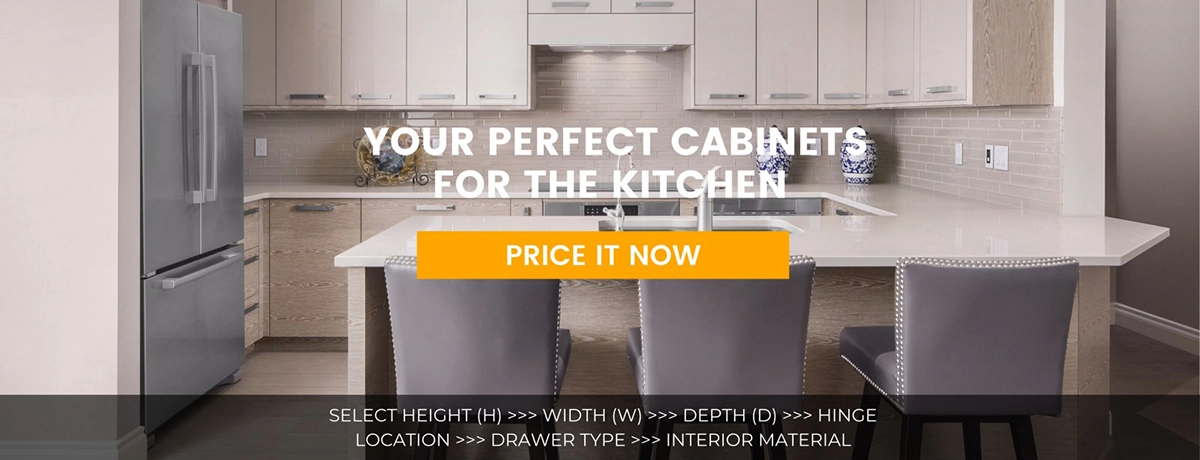Veneer cabinets in the kitchen. Is veneer good for kitchen cabinets?
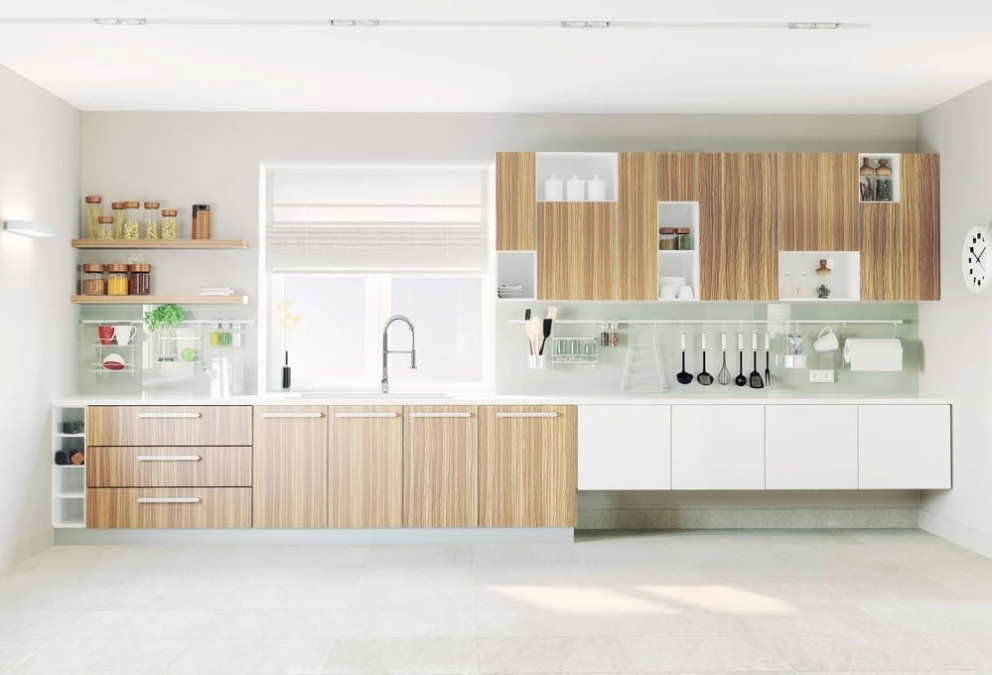
The time to make a kitchen makeover or renovation comes to every home eventually. A kitchen that looks weared does not bring satisfaction to its owners anymore. There is no joy in peeling paint or squeaky doors. There are a few options for homeowners to deal with cabinet malfunction. Depending on their overall condition you may repair and refinish the existing units, reface them with new doors and drawer fronts or fully replace cabinets with new ones. Obviously, the last option is the most expensive. Brand-new wooden cabinets with unique grain patterns may be a desirable option that costs a fortune.
With all the diversity of cabinet materials, the main choice you should make is whether you want solid wood or substrate for your kitchen set. Veneer sheets on kitchen cabinets have almost all the same qualities as solid wood units. This material has a few grades from the finest A-plus veneer grade with certain grain patterns to the most affordable C grade, which is used for less visible parts or cheap cabinets. You may choose to paint kitchen veneer cabinets and paint adheres even better to it than to solid wood. The reason is composite substrate does not tend to contract and expand in fluctuated humidity. This way paint will not chip and crack over time. Most natural wood veneers are easy to stain as well. If you do your research and choose good-quality veneer kitchen cabinets, it will be hard to say if they are not solid wood.
Wood veneer for kitchen cabinets is a popular finishing material for many kitchen styles from traditional to modern ones. Veneer kitchen design can be as attractive as natural wood but in a fracture of price. You may choose from different forms for kitchen cabinet veneer doors whether it is shaker style, flat panel, modern full overlay or classic flush doors. The door edges are usually sealed with edge banding to prevent moisture from going through. Proper edge trim and sealant make the kitchen cabinets and shelves with veneer layers durable and resistant to a busy kitchen environment. In this Cut2Size blog, we’ll explore types of wood used as a veneer, their properties and cases when you shouldn't use the material. We’ll delve into the most popular kitchen designs with veneer cabinets and share some tips on how to maintain them.
What is kitchen cabinet veneer?
Veneer is a thin layer of material, typically wood or engineering wood, that is applied to the surface of cabinets to create a seamless and sophisticated appearance. A kitchen cabinet door veneer offers a cost-effective alternative to solid wood cabinets while still delivering the same luxurious appeal. Veneer comes in a wide array of wood species, each showcasing its unique grain patterns and tones. From the timeless elegance of oak and maple to the rich warmth of cherry and walnut, there are veneer slab kitchen cabinet door options to suit every taste and style.
Kitchen cabinet veneer options
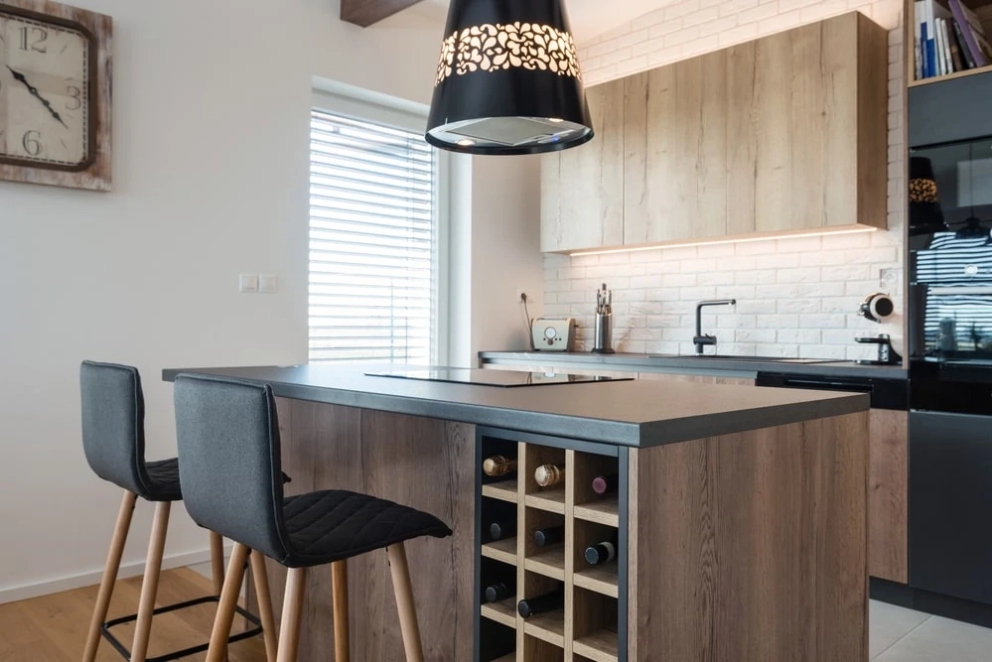
As a homeowner, understanding the various choices for kitchen cabinets is crucial, as they can significantly impact the overall aesthetics and functionality of your kitchen space. From luxurious wood veneer kitchen cabinet doors and boxes to more budget-friendly alternatives, we will delve into diverse materials and finishes, helping you make informed decisions for your kitchen renovation or remodelling projects.
Moreover, we'll shine a spotlight on the popular method of crafting kitchen cabinets using plywood with wood veneer, examining its merits and how it strikes a balance between elegance and cost-effectiveness. So, let's embark on this insightful journey into the world of kitchen cabinet door veneers and unlock the answer to the question: What is a veneer that is used on kitchen cabinets?
Modern veneer kitchen cabinets
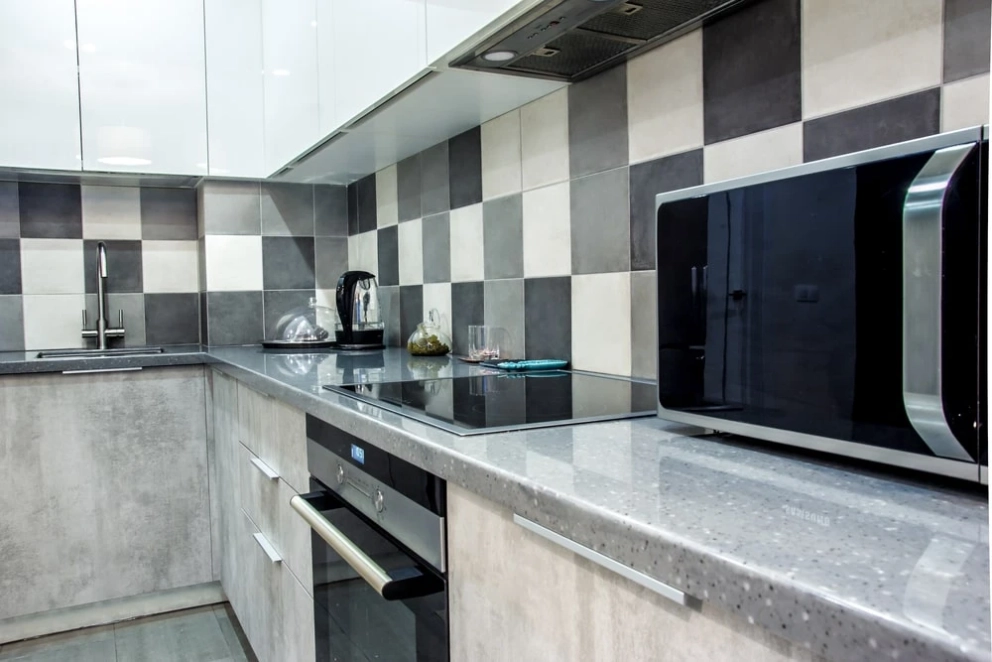
In this part of the blog, we invite you to explore the captivating realm of modern textured veneer kitchen cabinets. Discover how these cabinets have become synonymous with style and sophistication in contemporary kitchens. Additionally, we'll unveil the most popular and trendy kitchen cabinet veneer colours that are redefining the culinary space, providing valuable insights for your own modern kitchen design.
- White veneer for kitchen cabinets
Kitchen white cabinet veneer exudes timeless elegance and a sense of openness that can brighten up any culinary space. The clean and minimalist look of the kitchen cabinet's white veneer complements various kitchen styles, from modern to traditional. The versatility of a white kitchen cabinet veneer allows homeowners to pair it with different countertop materials and backsplash options. If you want a modern minimalist kitchen space, definitely go for a veneer for the kitchen cabinets white. White veneer for refacing kitchen cabinets is also a good idea if you’re quite unsure of your kitchen’s colour palette. Whether you desire a pristine, all-white kitchen or wish to use white as a base to accentuate other colours, white veneer kitchen cabinets offer a classic and inviting atmosphere.
- Grey veneer kitchen cabinets
Gray wood veneer modern kitchen cabinets have gained immense popularity due to their contemporary appeal and ability to create a chic ambiance. The sleek and muted tones of grey wood veneer perfectly blend with modern aesthetics, giving kitchens a touch of sophistication. Additionally, some designers have ventured beyond traditional wood veneers and explored alternative materials like wrapping kitchen cabinets with stone veneer, opting for cement veneer kitchen cabinets, and dark veneer for kitchen cabinets. These innovative choices add unique textures and shades to grey cabinets, contributing to a more distinctive and personalized kitchen design.
- High gloss veneer kitchen cabinets
High gloss kitchen cabinet veneer takes contemporary design to a whole new level with its striking appearance. The reflective surface of high gloss veneer creates a luminous and glamorous effect, making kitchens feel more spacious and brighter. This type of veneer is often applied to modern-style cabinets, accentuating their sleek lines and smooth surfaces.
It is crucial to note that high gloss veneer requires proper maintenance, as fingerprints and smudges may be more visible on its glossy surface. However, if well-cared for, high gloss veneer kitchen cabinets can be a stunning focal point that elevates the overall aesthetics of any modern kitchen. To make veneer kitchen cabinets shine, use a specialized furniture polish or wood cleaner designed for veneer surfaces and follow the product's instructions for a glossy finish.
Incorporating these various veneer options in your kitchen design allows you to play with colours, textures, and styles, enabling you to create a truly exceptional culinary space that suits your preferences and reflects your personality. Remember to consider factors like durability, maintenance, and compatibility with the overall kitchen theme when selecting the perfect veneer for your kitchen cabinets.
Wood veneer kitchen cabinets
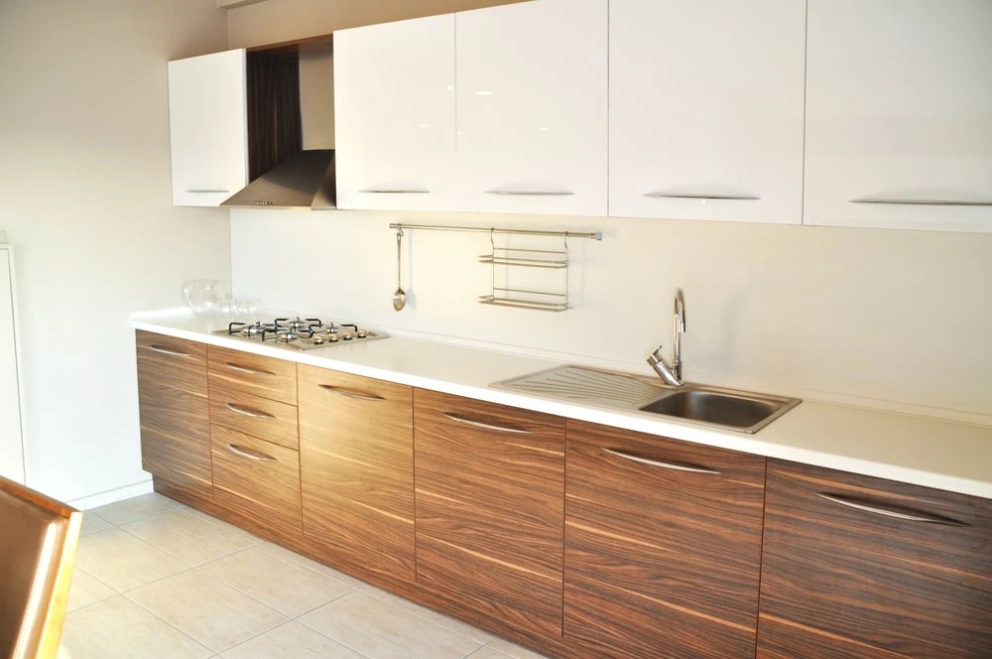
Kitchen cabinet wood veneer is perhaps the most popular type of veneer you can find and it is for good reason. Homeowners loved the look of natural wood and wood veneer cabinets’ kitchens have that appearance. Wood veneer kitchen cabinet doors are perfect for kitchens with a farmhouse or Scandinavian look. A wood veneer kitchen cabinet can be easily paired up with neutral colours which also makes it a good choice for home renovation beginners. Veneer wood kitchen cabinets come in different colours and styles as well.
Real wood veneer kitchen cabinets are also available in some cabinet manufacturing stores, including Cut2Size. If you are looking for veneer wood for kitchen cabinets such as timber veneer kitchen cabinets and other clean wood veneer kitchen cabinets, continue reading because, in this section, we will enumerate the different types of wood veneer kitchen cabinets. Read on and you might just find the best wood veneer for kitchen cabinets that will be perfect for your next kitchen renovation project.
- Birch veneer kitchen cabinets
Birch veneer kitchen cabinet doors are a popular choice for homeowners seeking a balance between affordability and a refined appearance. The pale and even grain of birch veneer kitchen cabinet shelves provide a light and natural feel to the kitchen space. Birch veneer shelf for kitchen cabinets is often used in contemporary or transitional kitchen designs, as they can be stained to resemble more expensive woods, such as cherry or maple. Birch veneer kitchen cabinets and white countertops are considered a great pair. They are also easily customizable, allowing homeowners to achieve various finishes and colours that complement their desired kitchen style.
- Cherry veneer kitchen cabinets
Cherry veneer kitchen cabinets and white countertops exude a rich and luxurious look, making them a classic and elegant choice for traditional and formal kitchen designs. The warm reddish-brown tones of dark cherry veneer kitchen cabinets deepen with age, showcasing its natural beauty. Cherry cabinets often come with intricate detailing and raised panel designs, further enhancing their sophisticated appeal. Regular maintenance, such as waxing and protecting them from direct sunlight, ensures that cherry veneer cabinets retain their lustre and splendour over time.
- Oak veneer kitchen cabinets
Oak veneer for kitchen cabinets has long been cherished for its durability, strength, and distinct grain patterns. Available in various finishes, including dark, medium, and white tones, oak veneer kitchen cabinets can complement a range of kitchen styles from rustic to contemporary. The prominent grain patterns add a touch of character and texture to the kitchen, making oak veneer cabinets a timeless choice that can withstand the test of time and changing design trends.
- Walnut veneer kitchen cabinets
Walnut veneer kitchen cabinets modern are prized for their exquisite dark chocolate hue and striking grain patterns that vary from wavy to straight lines. Black walnut veneer kitchen cabinets impart a sense of luxury and warmth, making it a perfect fit for upscale and modern kitchen settings. Its natural richness can be further enhanced with a clear varnish to protect the wood and intensify its captivating beauty. Walnut veneer cabinets are a statement piece that adds a sense of opulence and refinement to any culinary space.
- Java wood veneer kitchen cabinets
Java wood veneer kitchen cabinets showcase a deep, rich brown colour with subtle red undertones, making them a visually captivating choice for contemporary and exotic-themed kitchens. The dark and sophisticated appearance of java wood veneer can be heightened by using a matte or glossy finish to highlight its unique characteristics. This type of veneer imparts a sense of mystery and allure, instantly elevating the ambiance of the kitchen space.
- Teak veneer kitchen cabinets
Teak veneer kitchen cabinets are highly sought after for their exceptional durability and resistance to moisture, making them an ideal choice for humid kitchen environments. The golden-brown hue of teak veneer exudes a warm and inviting atmosphere, suitable for both modern and traditional kitchen designs. With its natural oils acting as a protective layer, teak veneer cabinets develop an attractive patina over time, enhancing their visual appeal and making them a cherished investment.
- Maple veneer kitchen cabinets
Maple veneer, with its pale, creamy appearance and subtle grain, offers a bright and versatile backdrop for various kitchen styles. When paired with white countertops, a timeless and clean aesthetic is achieved, creating a sense of airiness and openness. The combination of maple veneer kitchen cabinets and white countertops allows for endless possibilities in accessorizing and adding pops of colour, offering a canvas to accommodate diverse design preferences.
- Kitchen cabinets mahogany veneer
Mahogany veneer exudes an air of grandeur and sophistication, perfect for traditional and elegant kitchen designs. The deep reddish-brown colour of mahogany veneer kitchen cabinets showcases its regal nature, while its straight, interlocking grain adds a touch of drama and opulence. Regular maintenance with high-quality furniture polish will keep mahogany veneer cabinets looking lustrous and preserve their majestic allure.
- White ash veneer kitchen cabinets
White ash veneer kitchen cabinets offer a contemporary and light appearance, making them an excellent choice for modern and minimalist kitchen settings. The creamy-white hue of white ash veneer complements a variety of colour schemes and allows for the seamless integration of different kitchen elements. Its straight-grain patterns add a subtle visual interest that elevates the overall aesthetics of the kitchen space.
- Kitchen cabinet veneer brown chestnut
Chestnut brown veneer kitchen cabinets boast a warm and inviting colour that brings a cozy ambiance to any kitchen. The rich brown hue with reddish undertones provides a comforting and natural feel, making it suitable for both traditional and rustic kitchen designs. Its medium to dark tones can be complemented with earthy accents and natural materials, further enhancing the welcoming and organic atmosphere of the culinary space.
Solid wood or veneer kitchen cabinets
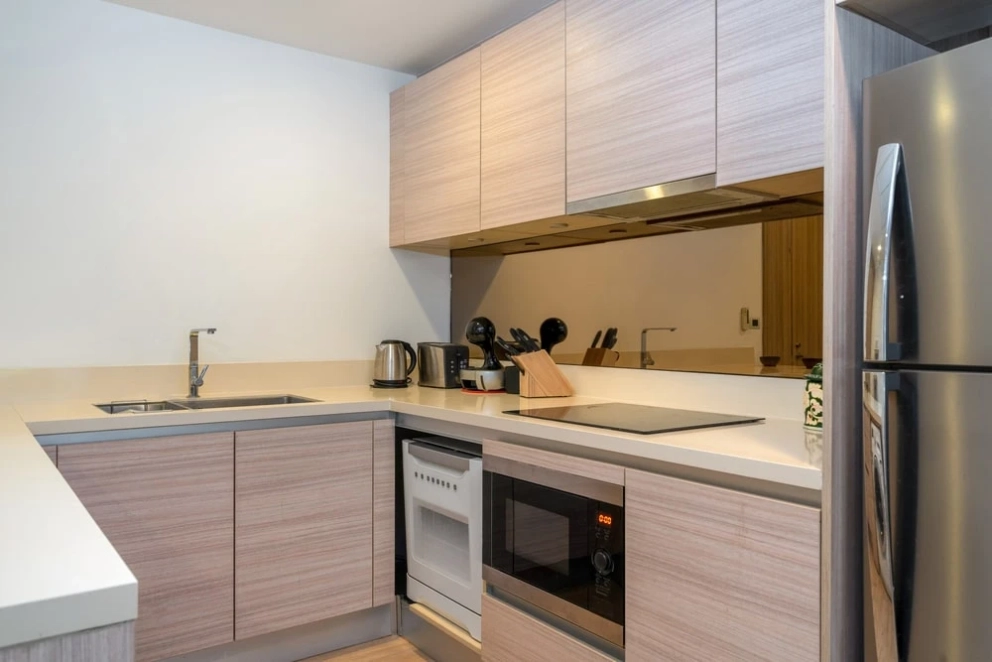
Let’s consider the two most popular options for wood finishing cabinets and find kitchen cabinets solid wood vs. veneer winner:
| Factors | Veneer kitchen cabinets | Solid wood kitchen cabinets |
| Cost | Generally more affordable than solid wood options; | Often more expensive due to the use of solid wood; |
| Thickness | Varies, typically between 0.4mm to 3,2mm; | Generally thicker, around 18mm to 25mm; |
| Pros | Wide variety of wood finishes and designs available; More eco-friendly as it uses less solid wood; Resistant to warping and cracking; Better resistance to moisture and humidity | Natural beauty with unique grain patterns; Exceptional durability and longevity; Can be sanded and refinished multiple times; Adds value to the home due to its solid wood build |
| Cons | May not last as long as solid wood cabinets; Repairs and refinishing can be challenging; Limited depth for sanding and refinishing. | More susceptible to warping and cracking; More prone to moisture-related issues; May have environmental concerns with deforestation. |
It's essential to weigh the veneer kitchen cabinet pros and cons, as well as solid wood kitchen cabinets based on your budget, desired aesthetics, and the level of maintenance you're willing to undertake. When the choice arises of veneer versus solid wood kitchen cabinets, veneer offers a cost-effective and environmentally friendly option with good resistance to moisture, and solid wood cabinets provide unmatched beauty, durability, and the ability to be refinished multiple times.
The thickness of the material can also impact the overall strength and sturdiness of the cabinets. The average thickness of wood veneer on kitchen cabinets is 0,5 – 0,6 mm, and with the thickness of the veneer, the cost will also rise. However, thicker doesn't always mean better. Generally, the average cost for veneer kitchen cabinets is CAD $3,200 vs. solid wood is CAD $4,600 for a standard-sized 10x10 kitchen.
How to repair peeling veneer on kitchen cabinets?
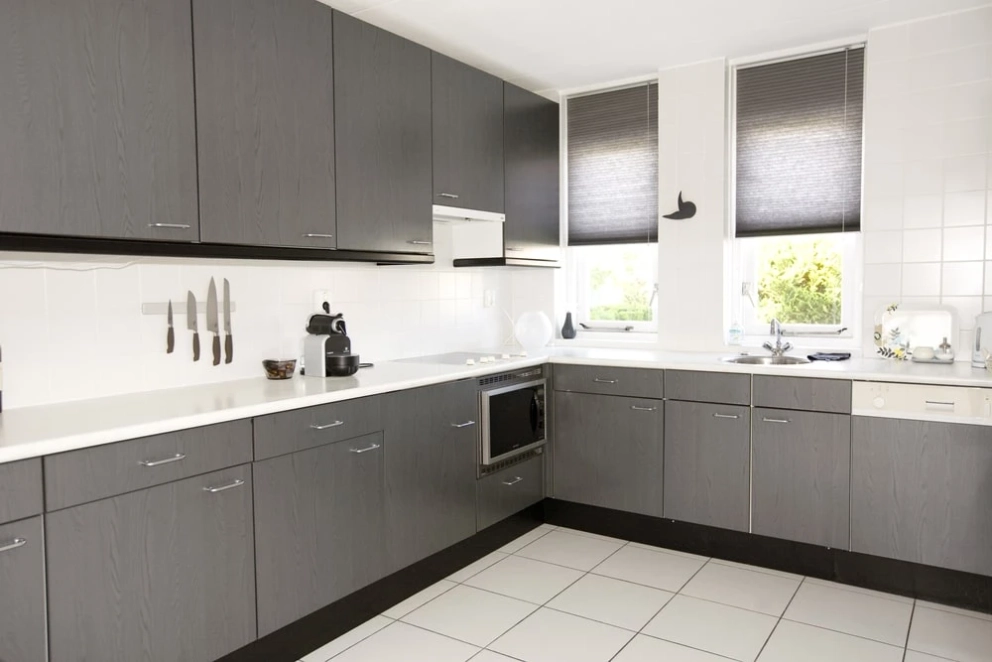
There's nothing more frustrating than discovering torn veneer on kitchen cabinets. Over time, wear and tear, exposure to moisture, or even age can cause the thin layer of veneer covering kitchen cabinets to start coming off, affecting the overall aesthetics of your kitchen. In this guide, we will walk you through step-by-step instructions on how to prevent veneer from peeling off kitchen cabinets and update wood veneer kitchen cabinets, giving them a fresh and revitalized appearance. Whether you want to fix splintered veneer or replace veneer on kitchen cabinets with a pristine white finish, we've got you covered. Let's dive in and restore the beauty of your kitchen cabinets with some easy and effective methods and ways to reface veneer kitchen cabinets.
- Assess the damage
Before diving into the repair process, carefully examine your veneer for kitchen cabinet doors to determine the extent of the peeling veneer. Take note of areas where the veneer is torn, coming off, or splintered. Assess whether it's feasible to repair or if replacement is necessary.
- Gather the necessary materials
To begin the repair of splintered veneer kitchen cabinets, you'll need some basic materials, including a utility knife, wood glue, sandpaper, a putty knife, clamps, and matching wood veneer or veneer repair patches. Ensure you have these tools ready before starting the restoration process.
- Repairing peeling veneer
For veneer coming off kitchen cabinets, gently lift the loose edges using a utility knife or putty knife. Clean the area underneath to ensure it's free of dust and debris. Apply wood glue to both the exposed surface and the backside of the peeled veneer. Press the veneer back in place, and use clamps to hold it firmly until the glue dries. Once the veneer is secured, use a damp cloth to wipe away any excess glue. Use sandpaper to smooth the edges and create a clean surface. Fill any gaps or holes with wood filler, and sand it down until the surface is even.
- Replacing veneer on kitchen cabinets
If the damage is beyond repair, replace the veneer on the kitchen cabinets white entirely. Remove the old veneer using a heat gun or iron to loosen the adhesive. Once the old veneer is removed, clean and sand the surface. Cut the new veneer or veneer repair patches to the appropriate size and shape, ensuring they match the existing veneer colour and grain pattern. Apply wood glue to the backside of the new veneer and carefully press it onto the cabinet surface. Use clamps to hold it in place until the glue dries completely. If you are not sure about the result, contact a woodworker professional.
Refacing kitchen cabinets veneer
For a more comprehensive update, you can consider putting veneer on kitchen cabinets with a new veneer covering. This process involves applying new veneer sheets to the cabinet doors and frames to give them a fresh and modern appearance. Choose from a wide variety of veneer options, including solid colours, wood grain patterns, and even white veneer for kitchen cabinet doors, to achieve the desired look.
Refinishing veneer kitchen cabinets is an excellent solution to give your culinary space a fresh and stylish makeover without the cost and hassle of completely replacing them. Whether you want to refinish veneer kitchen cabinets or remove veneer from kitchen cabinets and replace the existing veneer, this comprehensive guide will walk you through the step-by-step process of how to take veneer off of kitchen cabinets. Get ready to discover the secrets to achieving a beautiful veneer finish and elevating the charm of your kitchen to new heights.
- Assess your cabinets
Before embarking on replacing veneer on kitchen cabinets, carefully assess your veneer side panels for kitchen cabinets to determine their condition. Decide whether you want to refinish the existing veneer or remove and replace it with new veneer sheets. Consider the colour and design of the veneer you wish to apply, ensuring it complements your kitchen's overall theme and style.
- Removing veneer from kitchen cabinets
Start from the sides. To remove the existing plywood veneer sides on kitchen cabinets, use a heat gun or iron to gently heat the veneer surface. This will help loosen the adhesive, making it easier to peel off the veneer edging on kitchen cabinets with a putty knife. Take your time during this step to avoid damaging the cabinet's surface. Once the old veneer is removed, clean and sand the surface to prepare it for the new veneer application.
- Applying wood veneer to kitchen cabinets
How to apply wood veneer on the ends of kitchen cabinets or as veneer side panels? Start by measuring and cutting the veneer sheets to fit the cabinet surfaces accurately. Use a sharp utility knife to ensure clean edges. When applying wood veneer to kitchen cabinets, glue to the backside of the veneer and press it firmly onto the cabinet surface. Use a roller or a block of wood to smooth out any air bubbles or uneven spots. Secure the veneer with clamps until the glue dries completely.
- Wood veneer refacing kitchen cabinets
Whether you're putting veneer on painted kitchen cabinets or applying wood veneer to natural wood cabinets, the key to successful refacing is proper preparation and attention to detail. Sand the cabinet surfaces thoroughly to ensure a smooth and even finish. Apply multiple coats of high-quality wood finish to protect the veneer and enhance its natural beauty.
Painting veneer kitchen cabinets
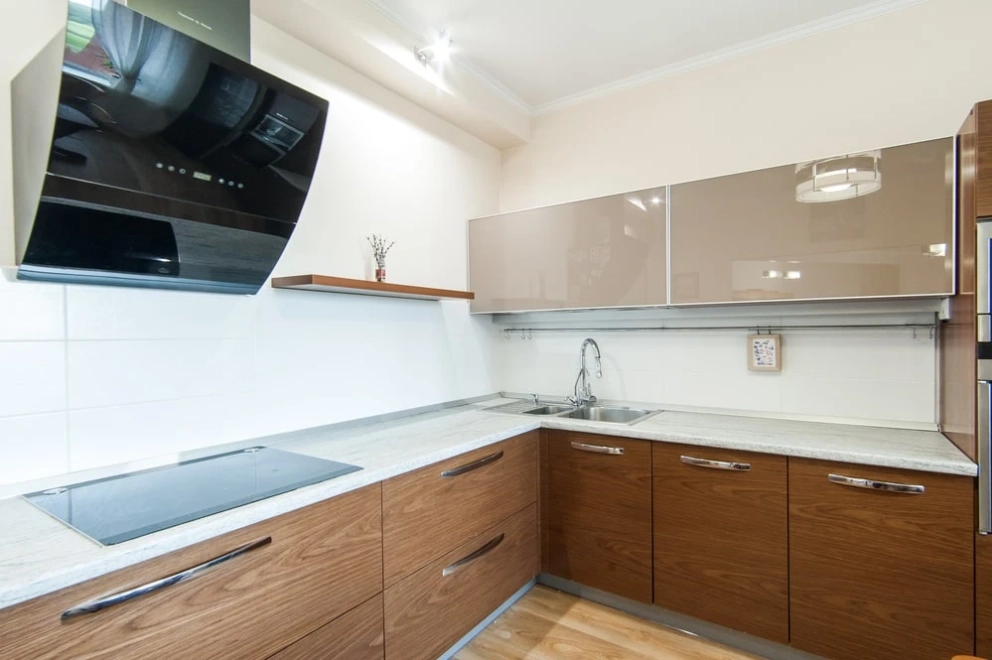
Paint for veneer kitchen cabinets can be a great way to give your kitchen a fresh and updated look without the cost of completely replacing them. To paint veneer kitchen cabinets white is a relatively simple process, but it requires proper preparation and the right materials to ensure a successful outcome. Here's a step-by-step guide on how to paint wood veneer kitchen cabinets:
Step 1: Remove cabinet doors and hardware
Start by removing the cabinet doors and any hardware (such as hinges and knobs) using a screwdriver. Lay the doors flat on a drop cloth or old sheets to protect your working area.
Step 2: Clean and sand the veneer
Using a mild detergent, clean the veneer surface thoroughly to remove any grease, grime, or kitchen residue. Once dry, lightly sand the veneer with fine-grit sandpaper to create a better surface for the primer and paint to adhere to. Sanding wood veneer kitchen cabinets can be risky as the veneer layer is thin and can easily be damaged. Attempting to refinish them might result in exposing the core material, affecting the cabinet's appearance negatively. Use a tack cloth or a soft cloth to wipe away any dust after sanding.
Step 3: Apply primer
Apply a primer that is specifically designed for veneer surfaces. This step is crucial to ensure the paint adheres properly and provides an even finish. Follow the manufacturer's instructions for the primer application, and allow it to dry completely.
Step 4: Paint the cabinets
Once the primer is dry, you can start by applying chalk paint on kitchen veneer cabinets. Use high-quality paint suitable for cabinets and apply it evenly using a paintbrush or roller. For the best results, it's recommended to apply multiple thin coats rather than one thick coat. Allow each coat to dry completely before applying the next one. This process will help you achieve a smooth and professional finish.
Step 5: Reattach hardware and cabinet doors
After the final coat of paint has dried, reattach the cabinet doors and hardware using a screwdriver. Make sure everything is properly aligned and tightened.
Staining over veneer kitchen cabinets
Staining veneer kitchen cabinets can be a bit more challenging than painting because veneer surfaces have a thin layer of real wood, and the colour may not absorb the stain as well as solid wood. If you have grey or black veneer kitchen cabinets and want to change the colour with stain, follow these steps:
- Prepare the cabinets
Clean the cabinets thoroughly and sand the veneer lightly to create a smooth surface for the stain to adhere to. Wipe away any dust with a tack cloth.
- Test the stain
Before applying the stain directly to the cabinets, it's a good idea to test it on a small, inconspicuous area to see how it reacts with the veneer. This will help you determine the right application technique and whether additional coats are necessary for the desired colour.
- Apply the stain
Using a clean cloth or brush, apply the stain evenly in the direction of the wood grain. Be mindful of drips and ensure there are no uneven patches. Allow the stain to penetrate the veneer as per the stain manufacturer's instructions.
- Wipe off excess
After the recommended time, wipe off any excess stains with a clean cloth. This step is crucial to prevent the stain from becoming too dark or uneven.
- Seal the stain
If you want to protect the stained cabinets and add a subtle sheen, you can apply a clear coat sealer after the stain has dried completely.
Supplies to repair veneer kitchen cabinets
To update veneer kitchen cabinets or repair splintered veneer kitchen cabinets, getting the following supplies should be the first on your list. Veneer for kitchen cabinets is suitable in the kitchen but to avoid veneer bubbling up kitchen cabinets, it is always required to know how to maintain them and know what materials are needed to keep them in good condition, especially if you are planning on using veneer for refinishing kitchen cabinets. Take note of the following supplies to repair veneer kitchen cabinets.
- Veneer panels for kitchen cabinets - Used for replacing damaged or missing kitchen cabinets veneer panels.
- Self-stick veneer for kitchen cabinets - Peel-and-stick veneer sheets that make repair work more accessible. It is applied by sticking on veneer for kitchen cabinets.
- Wood glue - Needed to secure loose or bubbling veneer back onto the cabinets.
- Wood filler - Used to repair chips, cracks, or splintered areas on the veneer surface.
- Putty knife - Helps apply wood filler and smooth it out for a seamless finish.
- Sandpaper (fine-grit) - Used for sanding down repaired areas and preparing surfaces for veneer application.
- Tack cloth - Essential for wiping away dust and debris during the repair process.
- Pegboard veneer for kitchen cabinets - A type of veneer designed with a pegboard pattern for a unique cabinet update.
- Wood veneer adhesive or contact cement - Used to attach wood veneer sheets for kitchen cabinets for them to be secure and sturdy.
